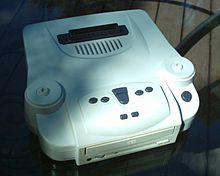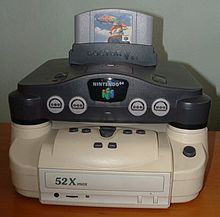- Doctor V64
-
The Doctor V64 (also referred to simply as the V64) is a development and backup device made by Bung Enterprises Ltd that is used in conjunction with the Nintendo 64. The Doctor V64 also had the ability to play Video CDs, audio CDs and had an option for applying stereo 3D effects to the audio.
Contents
History
The Doctor V64 came out in 1996 and was priced around $450 USD.[1] Many third party developers used the V64 in lieu of the PC64 Development Kit sold by Nintendo; the V64 was considered an attractive, low cost alternative to the expensive N64 development machine, which was manufactured by Silicon Graphics at the time. The CPU of the V64 is a 6502 chip (the CPU from the Nintendo Entertainment System); the operating system is stored in the BIOS chip. It is likely that Bung reused most of the design of their earlier NES clones in the Doctor V64.
The Doctor V64 unit contains a CD-ROM drive which sits underneath the Nintendo 64 and plugs into the expansion slot on the underside of the Nintendo 64. The expansion slot is essentially a mirror image of the cartridge slot on the top of the unit, with the same electrical connections, thus the Nintendo 64 reads data from the Doctor V64 in the same manner as it would from a cartridge plugged into the normal slot.
Using the Doctor V64 involved the solution of two problems: how to boot a game and how to save. In order to get around Nintendo's lockout chip, when using the Doctor V64 a game cartridge is plugged into the Nintendo 64 through an adaptor which connects only the lockout chip. The game cart used for operation had to contain the same lockout chip used by the game backup. The second problem concerned saving progress. Most N64 games saved to the cart itself instead of external memory cards. If the user wanted to keep his progress then the cartridge used had to have the same type of non-volatile memory hardware.
Following the Doctor V64's success Bung releases the Doctor V64 Jr. in December 1998. This was a cost-efficient condensed version of the original V64. The V64jr had no CD drive and plugged into the normal cartridge slot on the top of the Nintendo 64. Data is loaded into the V64jr's battery-backed RAM from a PC via a parallel port connection. The V64Jr had up to 512 megabits (64 MB) of memory storage. At the time this was done to provide for future Nintendo 64 carts that employed larger memory storage. The prohibitive high costs associated with ordering large storage carts kept this occurrence at a minimum. Only a handful of 512 megabit games were released for the Nintendo 64 system.
During the N64's lifetime, Nintendo made one model revision which made the serial port area smaller. This slight change in the N64's plastic casing made the connection to the Doctor V64 difficult to achieve without user modification. This revision may have been a direct reaction of Nintendo to discourage the use of V64 devices. It also explains why Bung decided to drop the use of this port in the latter V64Jr models.
The Doctor V64 could be used to read the data from a game cartridge and transfer the data to a PC via the parallel port. This allowed developers and homebrew programmers to upload their game images to the Doctor V64 without having to create a CD backup each time. It also allowed users to upload game images taken from the Internet.
Promotions
In 1998 and 1999, there was a homebrew competition known as "Presence of Mind" (POM), an N64 demo competition led by dextrose.com. The contest consisted in submitting a user developed N64 program, game or utility. Bung Enterprises promoted the event and supplied prizes (usually Doctor V64 related accessories). Though a contest was planned for 2000 the interest in the N64 was already fading and so did the event. POM contest demo entries can still be found on the Internet.[2]
Legal issues
The Doctor V64 unit was the first commercially available backup device for the Nintendo 64 unit. Though the unit was sold as a development machine it could be modified to enable the creation and use of commercial game backups. Unlike official development units, the purchase of V64s was not restricted to software companies only. For this reason the unit became a popular choice among those looking to pirate games.
Original Doctor V64 units sold by Bung did not allow the playing of backups. A person would have to modify the unit by themselves in order to make it backup friendly. This usually required a user to download and install a modified Doctor V64 BIOS. Additionally the cartridge adapter had to be opened and soldered in order to allow the operational procedure described early on this article. Though Bung never sold backup enabled V64s many re-sellers would modify the units themselves.
Nintendo made many legal efforts world wide in order to stop the sale of Doctor V64 units.[1] They sued Bung directly as well as specific store retailers in Europe and North America for copyright infringement. Eventually Nintendo managed to have the courts prohibit the sale of Doctor V64 units in the United States.[3]
As with many backup devices of its time, the Doctor V64 implemented text based menu driven screens. The menus were spartan and purely functional in nature. Utilizing the buttons on the V64 unit a user would navigate the menus and issue commands. It was mainly designed for game developers even though it is possible to back up cartridges with it (through the use of an unofficial V64 bios). Some of the menu items related to game backups were removed from the V64's BIOS near the end of its life due to pressure from Nintendo. These items are only available by obtaining a patched V64 BIOS.
Complete V64 menu listing Menu option Effect Alternate and BootCrack This option would load a workaround for booting games. It only worked on certain types of game images. Load Boot Crack Routine An advanced option that allowed uploading of program code for the use of boot related problems. Backup Card Auto → DRAM This option would read a game cartridge and store it in the V64's RAM. Backup Card Auto → PC Same as the previous option, but would transfer the data to a PC through the V64's parallel port. Manual Slide Show Auto Slide Show V64 Self Test Diagnostics routine would check all of V64's subsystems. Fully Test 128M DRAM Diagnostics routine would check only the first 128Mb of memory. Fully Test 256M DRAM Same as above but for those units with 256Mb of memory. Upload DRAM Data → PC Used in conjunction with then option "Backup Cart Auto → DRAM" this option would transfer the contents of Doctor V64's RAM to a PC through the use of V64's parallel port. Fix CRC Code → run game Another boot related command to enable playing of game images. It would only work on certain types of backups. Show Game Name in DRAM An advanced option that would read the backup image and extract the game's name displaying it on the screen. Upload V64 BIOS to PC Another advanced option for DV64 developers. It would transfer Doctor V64's own program code to the PC through a parallel connection. DX256 Upload to PC This command allowed operation of specific features of the DX256 cartridge adapter (an alternate cartridge adapter sold by Bung). PC Download to DX256 Swap Byte Order in DRAM This command would convert the game image's endianness of a game image already loaded in RAM. Later bios revisions would do this automatically, deprecating this option. Specifications
- CD-ROM access speed: Most early V64 models shipped with a standard IDE 8X CD-ROM . During the manufacturing lifetime of the device, latter V64 models shipped with 16X and eventually 20X drives. V64 units could be purchased without a CD-ROM drive. It is possible to replace the unit with a faster IDE CD-ROM unit.
- Many DrV64s shipped internationally were ordered without an installed CD-ROM drive, to save on shipping costs associated with weight, import duty on the drive and the ever increasing speeds of drives available. While theoretically a benefit in the user being able to use their own faster/cheaper drive, the variance in power draw of different manufacturers drives at different speeds caused issues with discs spin-ups up exceeding the wattage rating of the included Bung PSU. This led to users swapping out the Bung PSU for a more powerful model, or selecting low draw drives (mainly Panasonic drives sometimes badged as Creative).
- CD-Media: V64s can read CD-Rs and CD-RWs (provided the installed CD-ROM unit supports rewritable media). Supported media has to be recorded in Mode 1, ISO 9660 format. Doctor V64s only supports the 8.3 DOS naming convention. Joliet file system is not supported.
- RAM: 128 megabits (16 MB) or 256 megabits (32 MB). Original V64 units shipped with 128 megabits of RAM. V64 units started shipping with 256 megabits when developers started using bigger sized memory carts for their games. Users of the time had the option of buying a memory upgrade from Bung and other re-sellers.
- Power supply: The Doctor V64 uses a 4 Pin MiniDIN jack (as used for S-Video) for connecting the power supply cord. Power supplies included with Doctor V64s were very unreliable. Bung replaced the power supply with a sturdier version in later V64 units. Replacing broken power supplies became one of the most common maintenance problems with the V64. It is possible to modify an AT PC power supply for V64 use.[4]
Additional information
- The ROM extensions ".v64" and ".z64" started out as the preferred naming conventions by Doctor V64 and Z64 users respectively. It would also imply the file's 'endianness' as those units employed little endian (V64) and big endian (Z64) byte alignment. ".n64" was used as well but not as much (it became more popular as N64 emulators began to appear). The term ".v64" is still widely used today by the emulation community.
- Acclaim Entertainment subsidiary Iguana Entertainment used Doctor V64 units as their development hardware of choice during the N64's days. They were best known for developing the Turok, NBA Jam, NFL Quarterback Club, and South Park video games.[5][6]
See also
References
- ^ a b "Nintendo Pirating Device Still for Sale". Wired. June 6, 1997. http://www.wired.com/culture/lifestyle/news/1997/06/4504. Retrieved August 24, 2010.
- ^ [1][dead link]
- ^ [2][dead link]
- ^ [3]
- ^ "The Official "Thrift finds" Thread - AtariAge Forums - Page 132". Atariage.com. http://www.atariage.com/forums/index.php?s=&showtopic=18190&view=findpost&p=1144184. Retrieved 2011-11-18.
- ^ "[Oddities] - A day in the life of Turok 3". Web.archive.org. 2000-11-19. http://web.archive.org/web/20001119222300/www.dextrose.com/info/0428turok3dev.htm. Retrieved 2011-11-18.
External links
Categories:- Nintendo 64
- Unlicensed Nintendo hardware
Wikimedia Foundation. 2010.



